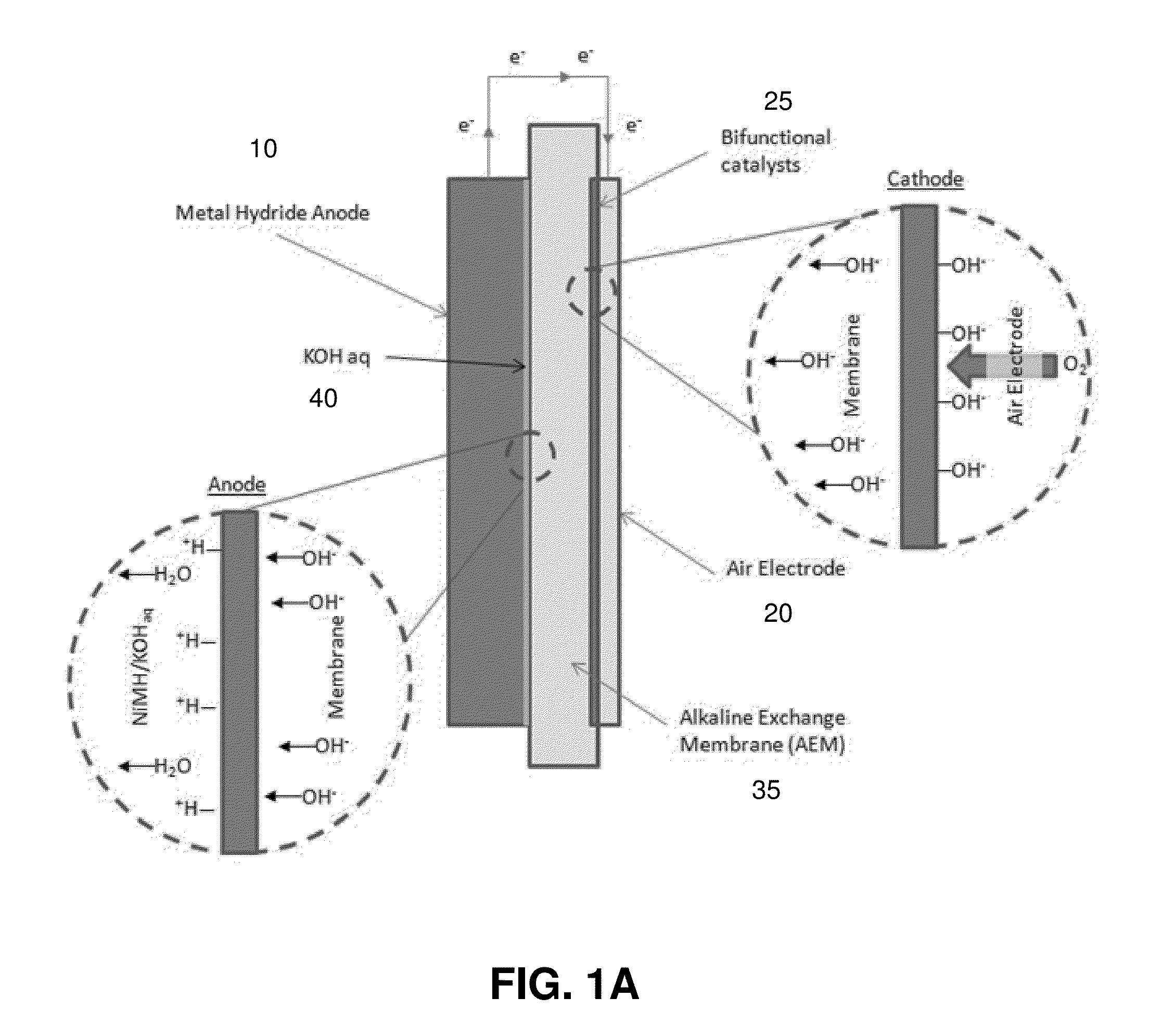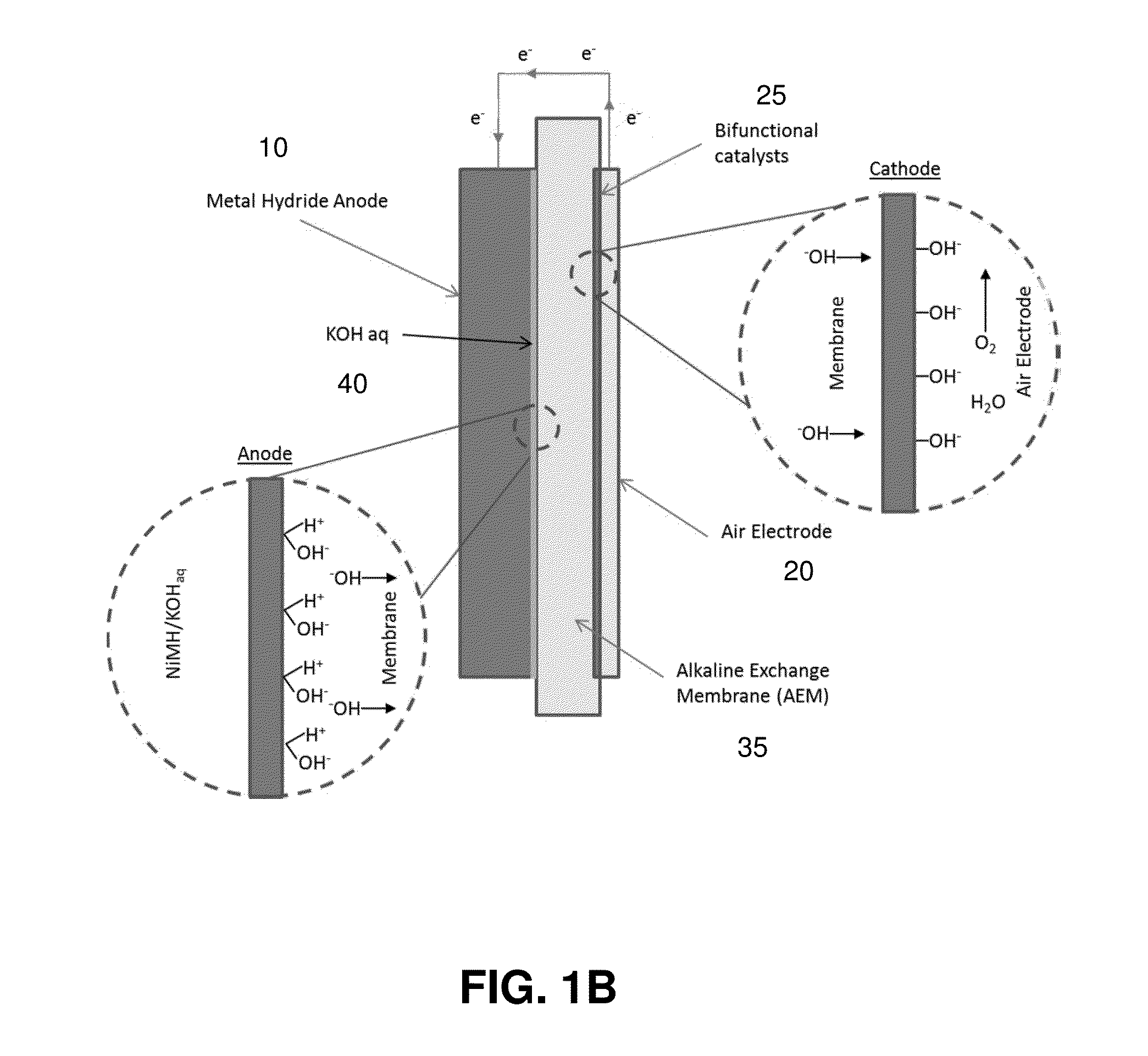Metal hydride-air (mh-air) battery for low cost storage applications
a technology of metal hydride-air and battery, which is applied in the direction of fuel and secondary cells, cell components, transportation and packaging, etc., can solve the problems of relatively low energy density of these batteries, and achieve the effects of high energy density, high energy density and cycle life, and convenient us
- Summary
- Abstract
- Description
- Claims
- Application Information
AI Technical Summary
Benefits of technology
Problems solved by technology
Method used
Image
Examples
example 1
Metal Hydride-Air Cell Configurations and Modeling
Cell Configurations
[0070]An exemplary metal hydride-air battery is comprised of a metal hydride (MH) anode, an alkaline exchange membrane, and an air electrode, as illustrated schematically in FIGS. 1A and 1B. FIG. 1A shows discharge, while FIG. 1B shows charge. Power is drawn from the system by discharging the metal hydride material (anode) 10. As the metal hydride material is discharged, it reacts with hydroxide ions generated at the air electrode (cathode) 20 to form water, as illustrated in the inset to the left of the FIG. 1A. The hydroxide ions are generated through the dissociation of oxygen and water at the surface of the air electrode as illustrated by the insert to the right of the FIG. 1A. In FIG. 1A, the bifunctional catalyst is indicated by reference label 25 and the aqueous electrolyte by reference label 40.
[0071]The electrochemical reactions are reversible and thus the metal hydride-air battery can be recharged by supp...
example 2
Fabrication of “Free Standing” Air Electrodes
[0079]A cathode structure can be fabricated by “direct deposition” techniques on an AEM. An AEM with a “free-standing” air electrode is shown in FIG. 5. The electrode area for this cell is 25 cm2 and is designed to operate in conjunction with a MH with a capacity of approximately 350 to 700 mAhr.
example 3
MH-Dual Air Electrode-Non-AEM Separator Test Cell and Test Results
[0080]A MH-air cell test fixture (FIG. 6) used for cycling studies consists of two square (25 cm2) poly(methyl methacrylate) porous plates securing a cell via four corner screws tightened with a torque wrench to provide defined, uniform stack pressure. We have found this simple design is also versatile, since it allows different prismatic arrangements of ORR, OER and MH electrodes and can be operated under ambient air or housed in a secondary containment vessel providing controlled environmental parameters (e.g. temperature, humidity, partial pressures of O2, CO2, N2 etc.) and supporting additional analytics (e.g. mass spectrometry, pressure analysis etc.).
[0081]MH-air cells were assembled in the configuration shown in FIG. 2a and consisted of the following components: 1) MH negative electrode comprising AB5 alloy (LaNi5 based with partial substitution, BASF), Ni powder (2O, Sigma Aldrich) in 75:20:5 wt % ratio presse...
PUM
| Property | Measurement | Unit |
|---|---|---|
| pH | aaaaa | aaaaa |
| concentration | aaaaa | aaaaa |
| electrical current | aaaaa | aaaaa |
Abstract
Description
Claims
Application Information
 Login to View More
Login to View More - R&D
- Intellectual Property
- Life Sciences
- Materials
- Tech Scout
- Unparalleled Data Quality
- Higher Quality Content
- 60% Fewer Hallucinations
Browse by: Latest US Patents, China's latest patents, Technical Efficacy Thesaurus, Application Domain, Technology Topic, Popular Technical Reports.
© 2025 PatSnap. All rights reserved.Legal|Privacy policy|Modern Slavery Act Transparency Statement|Sitemap|About US| Contact US: help@patsnap.com



